The Big 3 (Big 2 1/2, really, given Peter Pan's declining fortunes in recent years)
Jif, founded in 1958, triggered a 12-year food fight between the industry and the FDA because it contained an amazing 25 percent hydrogenated oil when it first came out.
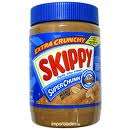
Skippy, founded in 1933, was originally made by the Rosefield Packing Co., which at one time was the largest manufacturer of pickles in the state of California.
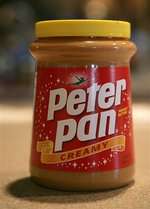
Peter Pan was made between 1928 and 1983 in Chicago. Its plant is now in Sylvester, Georgia, which was extensively redesigned following a 2006-07 Salmonella contamination.
Some of my favorite Indy peanut butters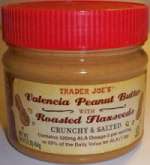
Trader Joe's Crunchy Valencia with Flaxseeds -- of all the peanut butters I sampled while conducting research for this book (and that was a lot), this was one of my two favorites for taste. It's currently unavailable because of Salmonella contamination at Sunland Inc. in Portales, NM.
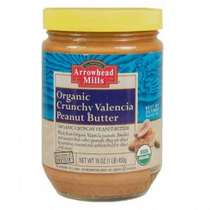
Arrowhead Mills Creamy Organic is the descendant of Deaf Smith Peanut Butter, a cult favorite during the 1970's. It's tied with Trader Joe's Organic Valencia With Flaxseeds as my favorite peanut butter.
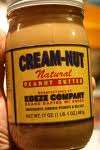
Koeze Cream-Nut, made in Grand Rapids, Mich., is one of the few peanut butters made from Virginia peanuts, and has an unusual coarse texture, midway between creamy and crunchy.
|
Excerpt, Followed by Table of ContentsMODERN PEANUT BUTTER WAS "INVENTED" IN THE AMERICAN MIDWEST IN THE 1890'S. THIS EXCERPT FROM THE BOOK'S THIRD CHAPTER LOOKS AT THE GROWING POPULARITY OF PEANUTS AND PEANUT BUTTER (ALTHOUGH NOT IN ALL QUARTERS) IN THE EARLY YEARS OF THE TWENTIETH CENTURY:
John Garwood, a young boy in Carroll, Nebraska, about this time, later recalled Roberts� Grocery there as �a mystic alchemy of smells � coffee, fresh bread, soap, spices, fruit, an oiled floor, grains and new leather. And then,� he adds, �there was peanut butter. With a heavy spoon, Mr. Roberts would ladle a couple of pounds from the large wooden tub. It wasn�t labeled chunky, super-chunky, regular, smooth, free of salt or sugar. There was just the sight and smell of the raw sin of all that peanut butter.� On one occasion at home, Garwood added, �My mother � anxious, I suspect, about our apple snatching in the high branches � called my friend and me down for a surprise. Inside a small box covered with a dish towel was punch, freshly baked bread and peanut butter. I noticed the misty look in my friend�s eyes. As we finished and lay back on the grass, there was a peace that passes all understanding.� While peanut products were becoming increasingly popular, there were holdouts. One evening in 1921, well after midnight, Joseph Burstein of Brooklyn�s Coney Island came home, woke his wife up and insisted she help him finish a bag of peanuts he�d bought on sale. As The Peanut Promoter noted, �she declined to share the succulent goobers.� �This seemed to enrage him,� Mrs. Burstein said, �and he emptied the bag in my face and forced me to swallow some of the nuts. He became abusive and finally ran out, only to return later, when he packed up his belongings and stayed away for three days.� Mrs. Burstein filed for divorce. Her aversion notwithstanding, peanut butter production took off in the first 20 years of the Twentieth Century. Two million pounds were produced in 1899; by 1907, that had grown to about 32 million pounds. In 1911, production declined to 23 million pounds, possibly because it was an El Nino year, with attendant drought and decreased agricultural production. But when the U.S. entered World War I, the government encouraged Americans to eat more peanuts and less wheat, as grain was needed by our European allies and the American armed forces. An ad for Beech-Nut peanut butter called it �a new patriotic way to conserve animal fats.� There were also practical considerations: Andrew F. Smith has noted, �As transportation space was limited by the war effort and unshelled nuts wasted valuable shipping space, demand grew for peanut products, such as peanut butter, that could be easily transported.� In 1914, 537,000 acres of peanuts were grown in the South; by 1918, that figure had risen to 4 million acres. In 1919, at the end of World War I, peanut butter production was 158 million pounds, nearly quintuple that of 1907. A 1919 article in The Peanut Promoter noted, �The consumption of peanut butter during the last three years more than equals that of all the previous years combined.� But that wasn�t enough for some in the peanut butter industry. In 1923, ten years before he founded Skippy, Joseph Rosefield of Alameda, California was making Luncheon brand, an unstabilized peanut butter. �Peanut butter is only eaten by a small percentage of our population,� he wrote in a peanut industry trade publication. �It should now be our effort to bring it to the attention of the general public so that it may, in time to come, be a common article of diet.� Peanut butter had achieved a measure of popularity. But despite national brands on the market such as Beech-Nut and Heinz, it was a mostly local and regional phenomenon. It might have remained so if not for Rosefield and an obscure inventor from Pittsburgh... *************************************************** CHAPTER OUTLINE OF THE BOOK:
CHAPTER ONE: Peanuts 101 Peanut butter consists mostly of ground-up peanuts. Everything you ever wanted to know about peanuts, including where they originated, how they got to the U.S., and their nutritional pluses and minuses. CHAPTER TWO: The Social Rise of the Peanut A look at the growing popularity of peanuts in the U.S. in the 19th Century up until the early 1890�s, when modern peanut butter was invented. CHAPTER THREE: The Birth of Peanut Butter The early days of peanut butter from its "invention" in the American Midwest in the 1890's until World War I, before peanut butter was stabilized. CHAPTER FOUR: Peter Pan: �Improved by Hydrogenation� The birth of Peter Pan in the Roaring '20's, where it was first made by Chicago meatpacker Swift. It becomes one of the first major brands to be hydrogenated (although not the first, as is commonly assumed), using a patent developed by Joseph Rosefield. When Peter Pan tries to short Rosefield on royalty payments for his patent, though, he jumps ship and founds Skippy. CHAPTER FIVE: How Peter Pan Lost Its Groove What happens to a peanut butter when it's sold several times in rapid succession and then suffers from a salmonella contamination? It loses its market dominance and falls to third place. CHAPTER SIX: "He Made His First Jar of Peanut Butter in his Garage" The early days of Skippy peanut butter. CHAPTER SEVEN: Skippy on Top Skippy becomes the market leader and a national icon, with commercial spokespeople including Mouseketeer Annette Funicello and iconic American artist Norman Rockwell. CHAPTER EIGHT: Jif: "But Is It Still Peanut Butter?" Procter & Gamble launches Jif in 1958. It's almost 25 percent lard, triggering a 12-year battle between the U.S. Food and Drug Administration and the peanut butter industry over a standard of identity for peanut butter. CHAPTER NINE: �Choosy Mothers Choose�� Jif climbs to the top of the peanut butter heap, thanks in part to the most famous slogan in peanut butter advertising. This chapter provides a behind-the-scenes look at how that campaign was created. CHAPTER TEN: Peanut Butter Goes International Although peanut butter is the all-American food, it's popular in some other countries, either because of American influence (Germany, Saudi Arabia)or their own indigenous traditions (Netherlands, Haiti). A look at which other countries like it and why. CHAPTER ELEVEN: The Music of Peanut Butter A brief critical survey of songs having to do with peanuts and peanut butter, including the Olympics' early-'60's doo-wop "Peanut Butter," Jimmy Buffett's "Peanut Butter Conspiracy (the title a probable hat-tip to the late-'60's folk-rock group of the same name) and obscure tracks like Don Byas' "Peanut Butter Blues." CHAPTER TWELVE: Deaf Smith: What�s Old-Fashioned is New Again The story of Deaf Smith Peanut Butter, which hit the market in 1970, triggering a revival of old-fashioned peanut butter and introducing Valencia peanuts to peanut butter. Includes a look at Frank Ford, the unlikely pied piper of natural peanut butter, a crew-cut Republican activist, military veteran and member of Campus Crusade for Christ who drew hippies by the Volkswagen van-load to Deaf Smith County, Texas. CHAPTER THIRTEEN: The Rise and Fall of the Florunner Until the early 1970's, most commercial peanut butter was a blend of Spanish and Virginia peanuts. But an unusually prolific and tasty runner peanut developed at the University of Florida in 1969 changes the very nature of American peanut butter. CHAPTER FOURTEEN: The Peanut Butter Crisis of 1980 As Don McLean would put it: the year the peanuts died. A severe drought across the South led to rationing by manufacturers and supermarkets, price spikes, hoarding by consumers, and massive importation of foreign peanuts. Chinese workers amused themselves by including dolls and even firecrackers with the peanuts, which their American counterparts had to carefully look for on the production lines. CHAPTER FIFTEEN: �You Mean It�s Not Good For Me?� In the 1980's and '90', public health concerns about fat, trans fats, allergies, and aflatoxin (a carcinogenic mold) hammered peanut butter sales, leading the industry to counterattack with a combination of solid nutritional research and stepped-up public relations. CHAPTER SIXTEEN: The Short, Happy Life of Sorrells Pickard The best-laid peanut butter business plans sometimes go awry. In the late '90's, Sorrells Pickard, a delicious, Dove-Bar-smooth peanut butter, had everything: a charismatic front man (country-western star Sorrells Pickard), a capable, peanut-butter-loving executive (Hollywood film editor and entrepreneur Herb Dow), a good busines plan and solid financing. But owing to overly rapid expansion and the collapse of the dot-com bubble, Sorrells Pickard didn't make it. A loving look at the peanut butter that got away, along with an evocation of the landscape in Jackson County in the panhandle of Florida, where Sorrells Pickard's peanuts were grown. CHAPTER SEVENTEEN: Peanut Corporation of America: "There Was No Red Flag" The notorious Peanut Corporation of America salmonella infestation of 2008-09. Unless you're an e. coli conservative, this chapter will make you realize the value of government regulation of the private sector. CHAPTER EIGHTEEN: Peanut Butter Saves the World Plumpy'nut and other therapeutic peanut pastes have an almost miraculous effect on Third-World starvation. Does Nutriset's Plumpy'nut patent keep more starving children from getting help, though, or is it simply doing a good job of keeping transnational giants such as PepsiCo out of the field? CHAPTER NINETEEN: Where are the Peanut Butters of Yesteryear? While there are more varieties and niche markets of peanut butter, there are fewer major companies making it, fewer shellers, and fewer peanut butter factories across the South. The book closes with reflections on the intrinsically American nature of peanut butter. *************************************************** |
|